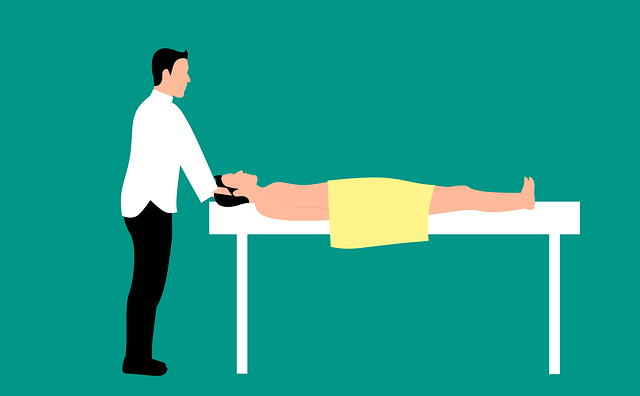Virtual therapy sessions revolutionize mental health care for depression and anxiety by offering home-based, accessible treatment. Utilizing video conferencing, these sessions provide real-time interactions with qualified therapists conducting therapeutic exercises and coping strategy training. Removing geographical barriers, virtual therapy enhances continuity of care, reduces stigma, and encourages open communication. Success requires technical savvy, flexible scheduling, and a supportive online space. Diverse treatment options like CBT, MBCT, and virtual exposure therapy prove effective. Overcoming challenges through interactive tools, clear communication, and secure platforms enhances efficacy. Measuring success involves quantitative assessments and qualitative feedback. The future of digital mental healthcare includes AI, VR, and AR for personalized, global access to quality treatment.
In today’s digital era, virtual therapy for depression and anxiety offers accessible, convenient support. This article delves into the world of online mental health care, exploring its understanding, benefits, and various types. We dissect effective appointment setting, technology’s role, and ways to overcome challenges in these innovative sessions. Additionally, we discuss success measurement and future trends, providing insights on how virtual therapy sessions are revolutionizing mental healthcare accessibility.
Understanding Virtual Therapy for Depression and Anxiety

Virtual therapy sessions have emerged as a powerful tool in the mental health arsenal, offering effective treatment for depression and anxiety disorders. This innovative approach leverages technology to connect individuals with qualified therapists from the comfort of their homes. Through video conferencing platforms, patients can engage in real-time conversations, participating in therapeutic exercises and exploring coping strategies just as they would in traditional face-to-face therapy.
The benefits of virtual therapy are significant. It overcomes geographical barriers, making mental health care more accessible to those living in remote areas or with limited mobility. Moreover, many people find the online format less intimidating, fostering a sense of safety and encouraging open communication. With a range of evidence-based techniques available, virtual therapy sessions provide a flexible and personalized experience tailored to each individual’s unique needs.
Benefits of Online Therapy Sessions

Virtual therapy sessions offer a convenient and accessible way for individuals seeking support for depression and anxiety. One of the key benefits is flexibility; clients can participate from the comfort of their own homes, eliminating travel time and making it easier to maintain consistent attendance. This accessibility is particularly advantageous for those with limited mobility or living in remote areas who might face barriers to accessing traditional in-person therapy.
Furthermore, online sessions provide a safe and confidential space for individuals to open up and share their experiences without the potential judgment or social pressures that may exist in a physical setting. The use of video conferencing technology allows for real-time interaction, fostering a sense of connection with therapists who can offer professional guidance and support. Through interactive tools and platforms, virtual therapy sessions enable personalized treatment plans tailored to individual needs, promoting effective management of depression and anxiety symptoms.
Setting Up Effective Virtual Therapy Appointments

Setting up effective virtual therapy appointments involves a combination of technical preparation, scheduling flexibility, and creating a supportive environment. Clients should be provided with clear instructions on using the chosen video conferencing platform, ensuring everyone is comfortable with the technology before the session begins. This might include testing audio and video quality, familiarizing themselves with sharing screens, and understanding privacy settings.
To accommodate different time zones and schedules, therapists should offer a range of appointment times, prioritizing flexibility where possible. Reminders and pre-session check-ins can help reduce no-shows and ensure clients feel supported and engaged. Creating a dedicated, quiet space for the session, free from distractions or interruptions, is crucial. This enables both client and therapist to focus on the therapeutic process, fostering a sense of connection and safety within the virtual environment.
Exploring Different Types of Virtual Therapy

Virtual therapy sessions have evolved significantly, offering a wide array of options for individuals seeking support for depression and anxiety. One prominent approach is cognitive behavioural therapy (CBT), which focuses on identifying and changing negative thought patterns and behaviours. Through interactive exercises and guided conversations, CBT virtual therapy sessions help patients develop coping strategies to manage their symptoms effectively.
Another popular method is mindfulness-based cognitive therapy (MBCT), combining elements of meditation and CBT. MBCT virtual therapy sessions teach individuals how to stay present and non-judgmental, fostering a sense of calm and resilience against depressive episodes. Additionally, exposure therapy in a virtual setting allows patients to confront fears in a safe, controlled environment, making it easier to manage anxiety disorders.
The Role of Technology in Mental Health Support

Technology has played a pivotal role in transforming mental healthcare, and virtual therapy sessions are at the forefront of this revolution. Online platforms offer accessible and convenient support for individuals dealing with depression and anxiety disorders. Through video conferencing, clients can connect with therapists from the comfort of their homes, removing geographical barriers and increasing privacy. This accessibility is especially beneficial for those who face challenges in attending in-person sessions due to busy schedules or physical limitations.
The integration of technology into mental health care provides various benefits, including improved continuity of care. Digital tools allow therapists to track progress, assess moods, and adjust treatment plans remotely. Additionally, virtual therapy sessions can be more cost-effective, making professional support more readily available to a wider population. This shift towards digital solutions has the potential to reduce stigma and increase help-seeking behaviors, ultimately contributing to improved mental well-being on a global scale.
Overcoming Challenges in Virtual Therapy Sessions

Overcoming challenges in virtual therapy sessions is essential for ensuring effective treatment of depression and anxiety. One major hurdle is maintaining patient engagement, as the lack of physical presence can lead to decreased motivation or disinterest. To overcome this, therapists must adapt their techniques to be engaging and interactive, utilizing digital tools for activities that foster connection and trust. Additionally, establishing clear communication norms and ensuring reliable internet access are crucial for successful virtual therapy sessions.
Another challenge is managing the potential for technical difficulties, such as poor audio or video quality, which can disrupt the flow of the session. Therapists should be prepared with backup plans and alternative methods to deliver treatment if technology fails. Moreover, maintaining confidentiality and ensuring patient privacy in a virtual setting requires additional precautions, including the use of secure platforms and clear guidelines on data protection. By addressing these challenges proactively, virtual therapy sessions can become as effective and beneficial as traditional in-person therapy.
Measuring Success: Evaluating Virtual Therapy Outcomes

Measuring success in virtual therapy for depression and anxiety is a multifaceted process, requiring careful evaluation of both qualitative and quantitative outcomes. Therapists utilize standardized assessment tools to track progress, such as the Beck Depression Inventory (BDI) and the Generalized Anxiety Disorder 7-Item Scale (GAD-7), which measure changes in symptoms over time. These tools provide measurable data on the severity of depression and anxiety, allowing for adjustments to treatment plans as needed.
In addition to quantitative measures, qualitative feedback from both clients and therapists is invaluable. Regular check-ins during virtual therapy sessions offer opportunities to discuss progress, challenges, and areas for improvement. This open dialogue ensures that the therapeutic approach remains tailored to the individual’s needs, fostering a sense of engagement and empowerment in the healing process.
Future Trends in Digital Mental Healthcare

The future of digital mental healthcare looks promising, with virtual therapy sessions poised to play an increasingly prominent role in treating depression and anxiety. As technology advances, we can expect more sophisticated platforms that leverage artificial intelligence (AI) and machine learning to personalize treatment plans based on individual needs and progress. These innovations promise to make therapy more accessible and convenient for patients worldwide, breaking down geographical barriers.
Furthermore, the integration of virtual reality (VR) and augmented reality (AR) technologies in mental health treatments might open up new avenues for immersive therapeutic experiences. VR could simulate calming environments or gradually expose individuals to anxiety-provoking situations in a safe and controlled manner, while AR could provide real-time feedback and support during daily activities. This trend suggests that the future of digital mental healthcare will be not only more accessible but also highly engaging and effective.
